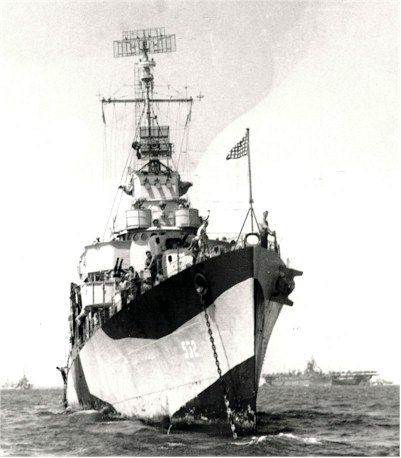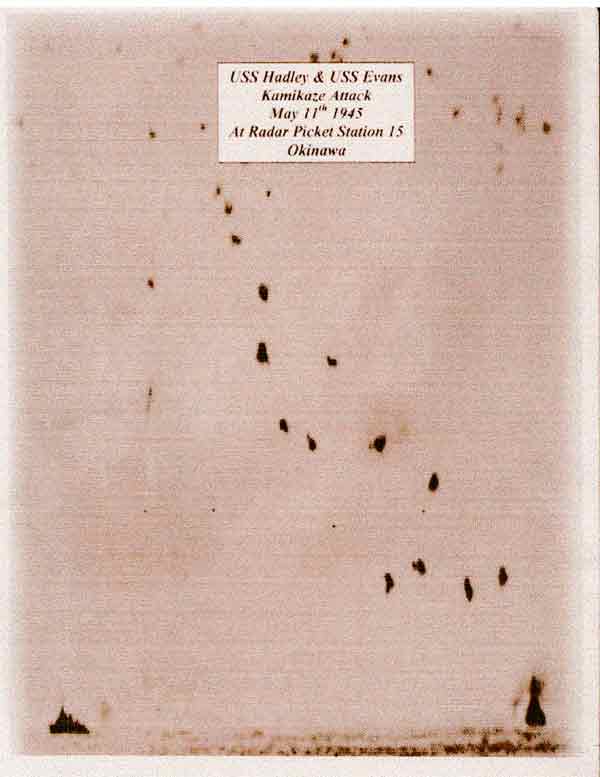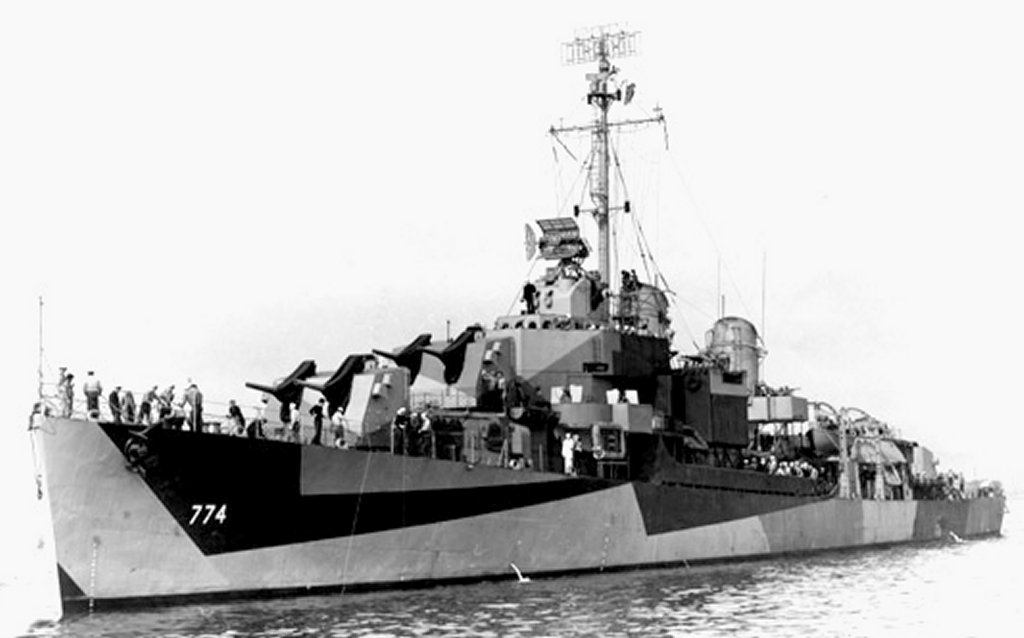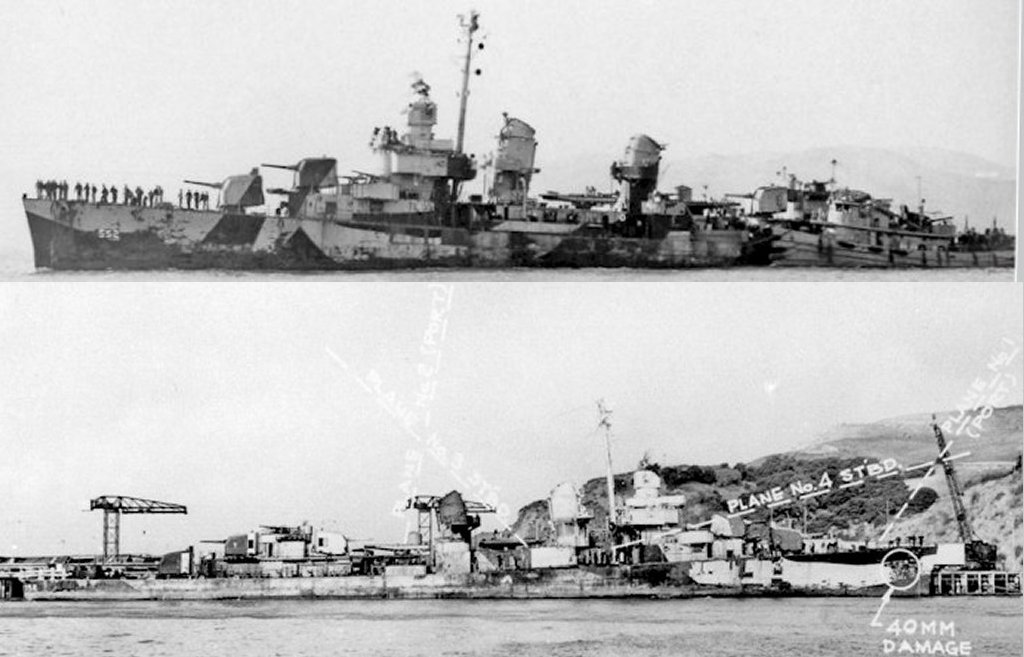







6/23/15
 |
 |
|

Construction of the Revell kit for the USS Evans Alumni Association
The USS Evans (DD552) was built in the Gulf Shipbuilding Company yards in Chickasaw, AL, and commissioned on December 11, 1943 at Mobile, AL. Commander F.C. Camp, USN, assumed command. The ship remained in Mobile until December 20 and then proceeded to New Orleans, LA, for a fitting-out period. Departing New Orleans on January 2, 1944, en route to Bermuda, the Evans arrived on January 6 and began her shakedown training. She completed shakedown training on February 4 and proceeded to Charleston, SC, where, on February 6, she began her post-shakedown yard availability. She left Charleston on February 18 in company with the USS Thomason (DE203) en route to Newport, RI. She arrived at Newport on February 20 and departed February 24 with Task Unit 20.2.2, consisting of the USS Cavalier (APA37), USS Funston (APA89) and USS Thomason (DE203). With Task Group 29.8 consisting of the same ships as Task Unit 20.2.2 plus the USS O’Hara (APA90) and the USS Freemont (APA 44), the Evans proceeded to Panama. Through the Canal to the Pacific Theatre On March 2, 1944, the Task Unit passed through the Panama Canal. Departing from Balboa on March 3 with Task Group 12.3, consisting of the same ships as Task Group 29.8 less the USS Thomason, the Evans arrived at Pearl Harbor on March 16 for a period of tender availability, full power trials and gunnery exercises. The Evans steamed from Pearl Harbor on March 23 with Task Unit 16.16.3, consisting of USS Cimmaron (AO22) and USS Halligan (DD584), to arrive at Majuro Atoll on March 29. Departing from Majuro on March 31 escorting USS Cimmaron to latitude 17-53N, longitude 170-01W, she proceeded independently to Majuro, arriving on April 5. From April 6 to May 12, as part of Task Group 57.8, the Evans conducted independent anti-submarine patrols of the following Japanese-held bases in the Marshall Islands: Jaluit, Wotje, Maloelap and Mille. Patrols were of approximately seven days duration and Majuro was the operating base. No contacts were made and no events of particular interest occurred. Departing from Majuro on May 13 in company with USS Hall (DD583) and USS David W. Taylor (DD551), the Evans arrived at Pearl Harbor on May 18 for an upkeep and training period. The Evans left Pearl Harbor on June 3 in company with Task Unit 16.6.7 and Task Unit 16.7.10, en route to provide logistic support to Marianas operations. On June 11, she rendezvoused with Task Group 50.17 (a fueling and aircraft replacement group), and proceeded to Marianas fueling areas, arriving in the vicinity of Saipan on June 14 where she escorted various units of Task Group 50.17 in fueling operations with Task Force 58 and Task Force 52 during the assault and capture of Saipan. First Shot at the Enemy On the evening of June 17, unidentified aircraft appeared on the radar screen. Task Group 52.14, which was operating about 15 miles to the southward, underwent an air attack resulting in damage to the USS Fanshaw Bay (CVE70). Two "Kates" were sighted to southward at about 8,000 feet. Fifty-three rounds of 5-inch 38-caliber ammunition were fired with no apparent damage to the planes. The enemy planes did not take offensive action against this task group. Friendly fighters and darkness prevented further attacks. The following day, several enemy aircraft were in the vicinity, just east of Saipan. Late in the afternoon, two groups of "Judys" composed of about eight planes each attacked the three tankers in company. All three tankers — USS Neshanic (AO71), USS Saugatuck (AO 75), and USS Saranac (AO74) — were damaged by bombs, and a salvage tug was required to tow the Saranac to Eniwetok. The bombers made no attempt to attack screening ships. The Evans expended 37 rounds of 5-inch 38, 925 rounds of 40mm, and 1,900 rounds of 20mm ammunition in the two attacks. One of the planes fired on by this ship was observed to splash but, as other ships were firing at the same target, only an assist is claimed by the Evans. Departing from fueling areas on June 27 in the screen of a tanker and escort carrier group, the Evans arrived at Eniwetok on June 29 and left on July 6 with a tanker group. She arrived in the Marianas fueling area on July 10 and joined Task Group 50.17 to conduct fueling operations with Task Force 52 and Task Force 58, returning to Eniwetok on July 28. Leaving Eniwetok again on August 3 with a tanker group en route to the Marianas fueling areas, she joined Task Group 50.16 on August 6 and conducted fueling operations in the vicinity of Guam and Saipan until August 11, returning to Eniwetok on August 14. Having completed duty in the Marianas operations with the Fifth Fleet, the Evans was assigned to the Third Fleet in Task Group 30.18 (fueling and aircraft replacement group) and operated with this group throughout Palau operations and the early stages of the Philippine campaign, servicing Task Force 38. The Evans departed from Eniwetok on August 29, escorting ships to Manus Island and to fueling areas in the vicinity of the Palau group, where she delivered mail to various elements of Task Force 38. On September 11, she received intelligence photographs of Philippine areas taken by Task Force 38 for delivery to Commander Fifth Air Force. After delivering the photographs on September 12, she returned to Manus on September 14. She remained in the area fueling Task Force 38 until October 28 and then departed to Ulithi with Task Unit 30.8.3, arriving on October 30. Commander Basquet N. Wev, USN, relieved Commander F.C. Camp, USN, as commanding officer on November 1. After conducting various fueling operations with Task Force 38, the Evans was assigned temporary duty with Task Force 38 and later assigned to Task Unit 94.6.2 (Ulithi Patrol and Escort Force). From December 30 to January 3, 1945, she conducted anti-submarine patrols in the area east of Ulithi harbor entrance, taking time out to escort a small convoy to Kossol Passage, Palau Group, on January 6. Hostilities Increase The Evans departed from Ulithi on January 11 in company with USS McCoy Reynolds (DD440) en route to conduct hunter Killer operations in the vicinity of Yap Island. An enemy submarine had been sighted two miles northeast of Yap early in the day. She searched eastern approaches to Yap and, during the evening of January 11 and the morning of January 12, conducted brief shore bombardment of Yap, firing at targets of opportunity from close range. She continued the search for the sub, extending sweeps to include the west side of the island, but with negative results. She returned to Ulithi on January 13. Assigned directly to Commander Fifth Fleet for special communication duties during preliminary operations against Iwo Jima and fast carrier strokes on Tokyo, the Evans departed from Ulithi on February 13 and transmitted special messages as directed by Commander Fifth Fleet, then proceeded to Saipan, arriving on February 16. The Assault on Iwo Jima After joining screen of Task Group 52.11 (Transport Group "Baker"), Evans proceeded to Iwo Jima. She took a screening station northeast of the island. She screening a transport group in a retirement area that night and returned to a screening station until noon on January 20, at which time she proceeded to a fire support sector (southeast side of the island) as directed by Commander Task Force 52, and conducted a shore bombardment until the next morning. The afternoon firing was destructive and was controlled by an aircraft spotter, while the night harassing fire was controlled from the island. During the launching of a counter attack by the Japanese at 0350 on the 21st, rapid neutralizing fire was delivered with nearly constant illumination. When relieved at 0645 by USS Capps (DD550), 1,889 rounds of 5-inch 38 ammunition had been fired. The Evans later rendezvoused with Task Unit 52.2.1 (Escort Carrier Group), taking station in the screen and operated with the escort carriers in the vicinity of Iwo Jima until March 8, and then proceeding to Ulithi for five days availability. Commander R.J. Archer, USN, relieved Commander Bosquet N. Wev, USN, as commanding officer of this vessel on March 12. Underway on the morning of March 21 in screen of Task Unit 52.1.2 (Escort Carrier Group 2), the Evans steamed to Okinawa Gunto, Nansei Shoto. Here she screened escort carriers conducting flight operations against Okinawa Gunto. On the evening of April 3, enemy aircraft were reported in the vicinity. The Evans commenced firing at a single Japanese plane (Zeke) approaching port quarter at a range of 7,000 yards. The plane attempted a suicide run on USS Capps (DD550) but a 5-inch hit scored by this vessel on the starboard wing and 40mm fire from Capps caused the plane to crash short of its objective. Capps and Evans were credited with an assist. During the attack, USS Wake Island (CVE65) was damaged by two near misses. On April 13, she set a southwesterly course for passage to the vicinity of Miyake Jima for neutralization of air operations against Sakashima Gunto. Returning on April 15 to support carrier operating area southeast of Okinawa Gunto, she continued screening escort carriers in the vicinity until May 2. While anchored in Kerama Retto Anchorage, Okinawa Gunto, for four-day availability, the Evans was attacked by two enemy aircraft — one "Judy" and one "Tony" — on the morning of May 6. The "Tony" made a suicide dive on USS St. George (AV16), crashing on her fantail. The "Judy" was unable to penetrate the fire from the ships’ anchorage and crashed behind a hill. This vessel expended 184 rounds of 5-inch 38 AA common and 32 rounds of 40mm ammunition. The Fierce Battle of May 11, 1945
On May 10, the Evans proceeded to Kerama Retto to fuel, then proceeded to Hagushi Beach, Okinawa Jima, and departed in the afternoon with USS Hugh W. Hadley (DD774) to radar picket station 15, northwest of Okinawa. Already on station as support were USS LSM(R) 193, USS LCS 82, USS LCS 83, and USS LCS 84. The Hadley assumed fighter director duties and the Evans support ship duties. Sighting a low-flying plane approaching port quarter at dusk, distance five miles, the Evans commenced firing, shooting down the plane (identified as "Kate") about 1,500 yards on port quarter. Expended 36 rounds of 5-inch 38 and 32 rounds 40mm ammunition. During the night, enemy aircraft were constantly in the area. Shooting down 15 enemy planes to set a new record of a "tin can" her size, the Evans fought off Japanese suicide divers for 73 minutes before four Kamikaze pilots scored against her. The Evans splashed 15 planes and chalked up four assists against the fanatic suicide divers in the 1-hour, 13-minute battle. It was estimated by the ships under attack in this action that more than 100 planes came in on the Evans, another destroyer, and two supporting LCS ships. The Hadley, a larger destroyer with more guns, was officially credited with 23 Japanese planes for an all-time Navy record. In addition to splashing 15 and scoring four assists, the Evans took four suicide crashes on her decks and hull, but stayed afloat to fight again.
Lieutenant Smith Describes Action The attack was described by Lieutenant James M. Smith, USN, of New Freedom, PA, the ship’s doctor, as a "whirlwind of planes coming at us from every direction. "Guns were firing as rapidly that reliefs had to be afforded to exhausted loaders," he explained. "The ship was surrounded with smoke from our own fire and it was difficult to spot the Japs because of the black shell bursts that mingled with them. "After 1 hour, 13 minutes of splashing all attacking planes, a kamikaze artist maneuvered through the barrage and winged over on the port bow. A hole at the water line, resulting from this hit, flooded one living compartment. In quick succession, hits two, three and four occurred. The second and third resulted in critical damage to the Evans. An ‘Oscar’ struck at the waterline on the port side. The flaming plane hurdled onto the fantail. Its bomb exploded under the after engineering spaces, flooding them immediately. "After the first hit, the executive officer, Lieutenant John W. Gilpin, USN, rushed aft to determine the damage sustained," the doctor added. "As he was returning, Lieutenant Gilpin was blasted over the side. Pat J. Macciocca, seaman first class, jumped to his rescue and saved the life of the wounded officer. Macciocca held up Lieutenant Gilpin until he could be taken aboard an approaching LCS. "With all power lost, the Evans lay dead in the water," Lieutenant Smith went on. "Smoke and steam billowed from the engineering spaces while flames licked about the forward torpedoes — one of which had been knocked from its tube and driven into the galley overhead. It was necessary to resort to small portable extinguishers and bucket brigades to bring fires under control. In spite of the efforts of the Evans’ crew, the ship probably could not have been saved from sinking had not salvage and rescue ships arrived promptly. "Meanwhile, first-aid parties rendered valiant services, rescuing wounded comrades who had fallen at their battle stations. After the wounded had received initial medical treatment, they were transferred immediately to a destroyer transport which rushed them to a hospital ship where the best of medical care is available." Several times during the 73 minutes of continuous attack, the main and secondary batteries took under fire successfully two and three planes attacking at the same time. Lieutenant Matthew C. O’Hearn, USNR, gunnery officer directed the firing. In the afternoon, the USS Arikara (AKA98) and USS Cree (ATF84) arrived to assist in salvage work. The Cree took Evans in tow on May 14 and proceeded to Kerama Rhetto, Okinawa Gunto. The DD552 entered drydock ARD 27 on May 28 for emergency repairs and remained there until June 7. She then moored in nest with USS Vestal (ASR4). Emergency repairs were completed by USS Vestal on June 18. She got underway from Kerama Retto in tow by USS Arikara (ATF98) on June 19 in company with USS Braine (DD630) and USS Waters (APD8), en route to Saipan. Evans arrived at Saipan on June 25. On June 26, she got underway from Saipan in tow by USS Startford Point (WSA Tug) en route to Pearl Harbor, and USS Levy (DE162) reported June 29 as escort. On June 30, USS Levy made two hedge hog attacks with negative results on sonar contact definitely evaluated as a submarine. USS Levy took departure on July 1. Arrived at Pearl Harbor on July 12. On July 16, Evans left Pearl Harbor, en route to San Francisco, in tow by M.V. Pigion Point (WSA Tug). Moored in Mare Island Navy Yard, California, on July 27, she commenced undergoing overhaul and battle-damage repairs.
All overhaul and repair work ceased on August 17, pending further instructions from Chief of Naval Operations. On September 10, instructions were received to decommission the Evans after survey board inspection. Commander John E. Pace, USN, relieved Commander R.J. Archer, USN, as commanding officer on August 28. 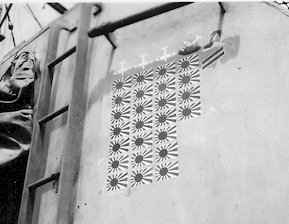
War Record: December 11, 1943 - October 1, 1945
Statistics:
|
||
 |
 |
